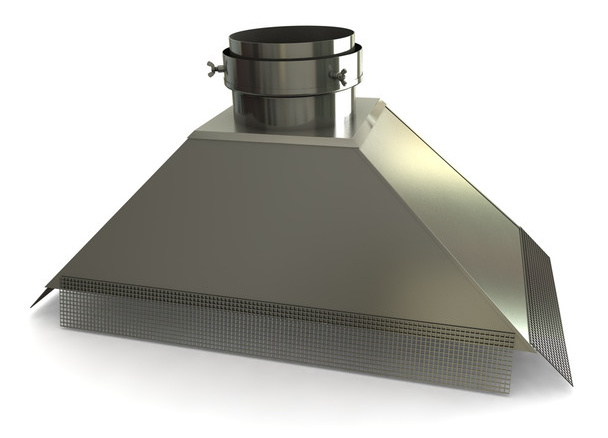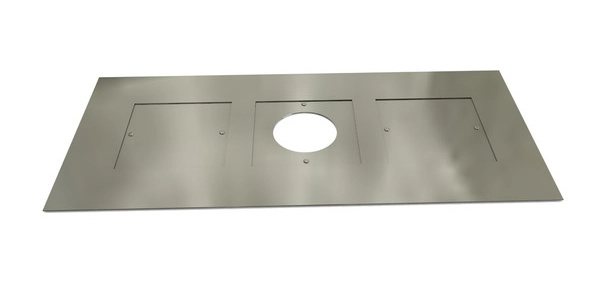Do You Need a Register Plate With a Flue Liner?
If you’re installing a new flue liner in your chimney, then you may be wondering if you also need to install a register plate at the same time. It’s a question that perplexes many people when they’re working on their chimneys and fireplaces. Keep reading and the Trade Price Flues team will provide you with the answer.
Do you need a register plate if you are using a wood-burning stove with a flue liner?
You do not have to use a register plate if you are using a flue liner with your stove.
However, we strongly recommend that you do use one. Not only do register plates provide the perfect finishing touch to wood-burning stove fireplace projects, but they have multiple practical benefits too (which we’ll cover later on).
Do you need a register plate if you are using an open fireplace with a flue liner?
What if you have an open fireplace in your home as opposed to a wood-burning stove?
As we’ve written previously, it’s highly recommended (and in some cases a legal requirement) to use a flue liner with an open fireplace.
But, what about a register plate?
The answer is that you shouldn’t use a register plate with an open fireplace. Register plates are intended for use with stoves only.

Shop Now - 8” Chimney Gather 300 mm x 600 mm
Instead, you should use what’s called a chimney gather. This is a metal ‘hood’ which sits at the base of the chimney cavity and connects to the flue liner.
A chimney gather does much the same job as a register plate, sealing up the base of a chimney, however it is shaped to accommodate the dynamics of a burning open fire.
What is a register plate?
If you’re new to the world of stoves and chimneys then you may be wondering what we actually mean when we talk about register plates.

Shop Now - Register Plate 1250 mm x 600 mm Galvanised Steel
A register plate is a flat metal sheet which is used to ‘box off’ the base of a chimney cavity. In other words, it’s like a ceiling that sits above your stove, forming a seal around the stove-pipe as it passes up into the chimney cavity.
Many register plates come with pre-cut holes which allow for a stove-pipe to pass through and subsequently connect to a chimney flue liner.
Some register plates also feature small access hatches, which can be opened to provide access to the inside of the chimney cavity without having to completely remove the register plate.
A note on closure plates
As we’ve previously written on our sister website, you can actually find what are known as closure plates too.
The distinction between the two is as follows:
> ‘A register plate is used to seal the base of a chimney cavity when you do not have a chimney flue liner in your chimney.
> A closure plate is used when you do have a chimney flue liner in your chimney’.
The main difference between the two is that a register plate helps to prevent smoke, soot, ash and other combustibles from falling back down into your living space (if you’re using a stove without a flue liner).
Whereas, a closure plate is mainly an aesthetic addition, helping to seal up the base of the chimney.
Register plate as a generic term
Having said that, however, there isn’t really a huge practical difference between closure plates and register plates.
In fact, they are very often interchangeable - with many people in the chimney and flue industry simply using the generic term ‘register plate’ to refer to both types.
So, whether you hear the term register plate or closure plate, the term refers to essentially the same thing - a metal plate that sits above a wood-burning stove, sealing up the base of the chimney cavity.
What are the benefits of using a register plate?
As you’d probably expect from the team here at Trade Price Flues, we always recommend using a flue liner with your wood-burning stove.
That’s because aside from making the inside of your fireplace look neat and tidy, a register plate also has a number of practical benefits.
We’ve detailed the various practical benefits of using a register plate below.
Prevent heat loss
Even if you’re using a flue liner with your stove, adding a register plate can prevent further heat loss. This is especially true if your chimney is of the older Class 1 variety.
A register plate acts as a physical barrier and will prevent heat that is building up in your room from escaping up the chimney. Conversely, a register plate can also help prevent cold air and gusts from travelling down your chimney and into your living space.
Protect your home from falling debris
If you’ve got a large, older-style chimney, then you’ll be aware that chimneys are magnets for all kinds of debris and detritus.
Whether it’s leaves, twigs, and bits of old bird nests or it’s soot, ash and bits of creosote, a register plate can prevent these things from falling down the chimney and messing up your fireplace and living room.
Improve your chimney’s draw
The key to getting your stove performing at its best is to ensure that your chimney is creating a strong ‘draw’.
This refers to the cycle, driven by negative pressure, where air is pushed into the fire and then pulled up and out of the chimney.
If air is able to travel past and beside the stove and up the chimney, this will reduce the effectiveness of your stove’s draw. A register plate can reduce this problem by removing the spaces where air can escape, helping to ‘funnel’ air into the stove’s fire.
Contain chimney insulation
If you decide to insulate your chimney - and we strongly recommend that you do, especially if you have an older brick and mortar chimney - then a register plate can help contain the insulation material.
For example, if you choose to insulate your chimney using vermiculite, then this will typically be poured down into the gap between your flue liner and the inside walls of the chimney cavity. A register plate will provide a base for this poured vermiculite to sit on.
Buying the right register plate for your stove and fireplace
Hopefully we’ve convinced you of the benefits of adding a register plate to your fireplace. However, if you’re going to get one, what should you look for?
You’ll find our top register plate buying tips below.
Register plate material
First and foremost, you’re going to want to buy a register plate which is made from high-quality galvanised steel.
Galvanised steel features a protective zinc coating which adds an extra element of durability and corrosion resistance, meaning it’ll have a longer service life.
In terms of the thickness of a register plate, you want it to be thick enough to withstand falling debris. But you don’t want it to be so heavy that it requires lots of work to be fixed in place at the throat of your chimney.
Here at Trade Price Flues, we believe we’ve struck the perfect balance, with the majority of our register plates being made from galvanised steel that’s between 1 mm and 1.5 mm thick.
Fixing brackets
When it comes to fitting a register plate in the throat of your chimney, it’s best to buy one that includes brackets. Brackets make it super easy to fix the register plate in place and ensure a flush fit with the dimensions of your chimney cavity’s opening.
Register plate size
For your register plate to work effectively, it’s vital that it fits within the throat of your chimney to tight tolerances. You don’t want any gaps where the edge of the register plate meets the inside wall of the chimney.
As such, it’s important you measure the throat of your chimney carefully and select the correct size register plate. If you find that the throat of your chimney is of unusual dimensions, it’s possible to buy register plates which can be cut down to fit.
Pre-cut or not?
When you’re shopping for a register plate, you’ll find that it’s possible to buy register plates that have pre-cut holes for the stove-pipe to pass through.
However, in the event you are removing your stove and closing up the base of your chimney, then it’s possible to buy register plates which don’t have pre-cut holes.
Note - if you do buy a register plate with a pre-cut hole, it’s important that the hole is of the correct diameter to fit your stove’s pipe.
Sealing plates
In addition to a register plate, you may also require what’s known as a sealing plate.
A sealing plate is used to create a seal where the stove-pipe passes through the register plate. They are often used as the pre-cut holes in register plates are usually a little wider than the diameter of the stove-pipe.
Note - explore our complete range of sealing plates now.
Where to buy register plates UK?
We hope you’ve found our guide to using a register plate with a flue liner useful. And, hopefully we’ve made the case that even if you’re using a flue liner with your stove, it’s a good idea to use a register plate too.
If you’re looking to buy a register plate to go with your wood-burning stove, then buy one from Trade Price Flues.
Not only do we stock one of the internet’s best ranges of register plates, but we also offer nationwide delivery, and free delivery on orders over £150.
Plus, if you require any advice prior to making a purchase, our friendly, expert team is on hand to help. You can speak to them on 0161 7300 969 or by email at: sales@tradepriceflues.co.uk.
Shop register plates at Trade Price Flues now
For more chimney and flue advice, read the Trade Price Flues blog…
When Do You Need to Replace a Flue Liner? | How Much Does It Cost to Fit a Chimney Liner? | How to Stop Birds Nesting In Your Chimney
Latest Articles
-
Air Pollution Down in the UK Despite Record Wood Burner Sales
Great news! Wood-burning stoves, once considered environmental villains, have transformed into eco-f …18th Apr 2024 -
A Guide to Stove Installation in Lodges, Sheds, and Shepherd’s Huts
Shepherd’s huts, lodges, and sheds have become increasingly popular as charming retreats or alternat …25th Mar 2024 -
Pinned vs. Pinless Moisture Meters: Which is Best for Firewood?
When you collect or buy firewood, it usually starts very moist inside. Using sopping wet wood to bur …4th Mar 2024






